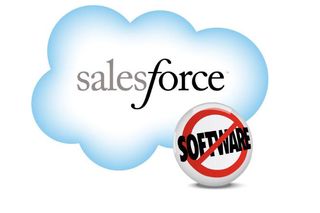Dreamforce 2011: Can Salesforce.com become a serious PaaS player?
With so many PaaS players coming to market, what is Salesforce.com doing?

ANALYSIS If you are looking for a cloud platform, more and more options are appearing on the table.
Salesforce.com this week pushed on with its own Platform-as-a-Service (PaaS) efforts, a side of the cloud vendor that doesn't actually produce a significant amount of income.
The cloud vendor still gets most revenue from its CRM services. Around 90 per cent of Salesforce.com revenue comes from its Sales and Service Cloud offerings.
However, Salesforce.com only really asserted itself in the PaaS sphere when it announced the acquisition of the Heroku platform at last year's Dreamforce event.
At Dreamforce 2011, Salesforce.com made a few additions to its PaaS service, without producing anything earth shattering. In particular, it talked up the recent development of Java capabilities for Heroku, which previously only catered to developers using the Ruby on Rails, Clojure and Node.js languages. It also made Heroku Enterprise Packages available. Evidently, Benioff is trying to appeal to more developers and make some real money from its PaaS products.
Salesforce.com is taking a slightly different tack to competitors with its PaaS strategy, focusing on the "social enterprise platform." Essentially, it is using its platforms for the drive to supporting "social enterprises." It wants to see companies develop apps on Force.com and Heroku with a social slant, tying them into everything else Salesforce.com does.
Right now, the plan is to continue with Force.com as it is, and to continue as Heroku as it is.
Get the ITPro. daily newsletter
Receive our latest news, industry updates, featured resources and more. Sign up today to receive our FREE report on AI cyber crime & security - newly updated for 2024.
"There is no separation between our applications and our platform," CEO Marc Benioff said during a Q&A session today.
"These are not separable parts it's all one system, it's a service and it's an integrated system."
Complexity
Nevertheless, the company is running cloud platforms as separate entities like any other vendor in the space. If Salesforce.com does want to gain more supporters for its PaaS services, however, it would do well to make its offerings less complex. Its current lineup might leave IT guys more disoriented than a toddler trying to understand Ulysees.
With Force.com, which includes a range of platform services like VMforce and Appforce, as well as Heroku, it makes for a somewhat confusing brew. There are a number of pertinent questions here. Why has Salesforce.com kept advertising VMforce, which provides for Java developers, now that Heroku is appealing to that dev base? VMforce itself has now been phased out, without ever having had a customer, so surely its time to remove it from the Salesforce.com website.
Will Salesforce.com bring its PaaS projects together into a single, less befuddling package? It would seem wise to have one overall offering rather than bits and pieces. Yet there are no plans to bring Force.com and Heroku together.
"Right now, the plan is to continue with Force.com as it is, and to continue as Heroku as it is. There will be some places where you can integrate across the two, but the current plan is to not combine them into one single offering," said Eric Stahl, senior director for product marketing in EMEA at Salesforce.com.
"They are two different types of platform for two different types of developers. It's up to the customer to choose which one to use."
Tom Brewster is currently an associate editor at Forbes and an award-winning journalist who covers cyber security, surveillance, and privacy. Starting his career at ITPro as a staff writer and working up to a senior staff writer role, Tom has been covering the tech industry for more than ten years and is considered one of the leading journalists in his specialism.
He is a proud alum of the University of Sheffield where he secured an undergraduate degree in English Literature before undertaking a certification from General Assembly in web development.





